Are EPB41 and alpha-synuclein diagnostic biomarkers of sport-related concussion?Findings from the NCAA and Department of Defense CARE Consortium
Ray Vor,Crsta Dvoto,Toty B.Mr,C La,Su Yu,Stv P.Broo,Sara Mta,†,Toas W.MAstr,Crstopr C.Gza,Hyu-Su K,Da Hur,Jarosaw Harza,Kt L.Caro,Gra MGty,Joata Jaso,Kv M.Guswz,Jaso P.Ma,Aso Broos,Sta Dua,Stv Rowso,Lsay D.Nso,Pau Pasqua,Ma A.MCrJssa M.G*,t CARE Cosortu Ivstators
a Johns Hopkins School of Nursing and Medicine,Baltimore,MD 21205,USA
b National Institutes of Health,Bethesda,MD 20892,USA
c Department of Neurosurgery,Medical College of Wisconsin,Milwaukee,WI 53226,USA
d Predictiv Care,Inc.,Mountain View,CA 94086,USA
e Michigan Concussion Center,University of Michigan,Ann Arbor,MI 48109,USA
f Department of Psychiatry,Indiana University School of Medicine,Indianapolis,IN 46202,USA
g Departments of Pediatrics and Neurosurgery,University of California at Los Angeles(UCLA),Los Angeles,CA 90024,USA
h Department of Epidemiology and Biostatistics School of Public Health-Bloomington,Indiana University,Bloomington,IN 47405,USA
i John A.Feagin Sports Medicine Fellowship,Keller Army Community Hospital,West Point,NY 10996,USA
j United States Air Force Academy,Colorado Springs,CO 80840,USA
k Mathew Gfeller Center,Department of Exercise and Sport Science,University of North Carolina at Chapel Hill,Chapel Hill,NC 27514,USA
l Department of Orthopedics,Division of Sports Medicine,School of Medicine and Public Health,University of Wisconsin,Madison,WI 53705,USA
m Department of Biomedical Engineering and Mechanics,Virginia Tech,Blacksburg,VA 24061,USA
n Center for Neuroscience&Regenerative Medicine,Uniformed Services University,Bethesda,MD 20814,USA
Abstract Background: Current protein biomarkers are only moderately predictive at identifying individuals with mild traumatic brain injury or concussion.Therefore,more accurate diagnostic markers are needed for sport-related concussion.Methods: This was a multicenter,prospective,case-control study of athletes who provided blood samples and were diagnosed with a concussion or were a matched non-concussed control within the National Collegiate Athletic Association-Department of Defense Concussion Assessment,Research,and Education Consortium conducted between 2015 and 2019.The blood was collected within 48 h of injury to identify protein abnormalities at the acute and subacute timepoints.Athletes with concussion were divided into 6 h post-injury(0-6 h post-injury)and after 6 h postinjury (7-48 h post-injury) groups.We applied a highly multiplexed proteomic technique that used a DNA aptamers assay to target 1305 proteins in plasma samples from athletes with and without sport-related concussion.Results: A total of 140 athletes with concussion (79.3% males;aged 18.71 ± 1.10 years,mean ± SD) and 21 non-concussed athletes (76.2%males;19.14±1.10 years)were included in this study.We identified 338 plasma proteins that significantly differed in abundance(319 upregulated and 19 downregulated) in concussed athletes compared to non-concussed athletes.The top 20 most differentially abundant proteins discriminated concussed athletes from non-concussed athletes with an area under the curve (AUC) of 0.954 (95% confidence interval: 0.922-0.986).Specifically,after 6 h of injury,the individual AUC of plasma erythrocyte membrane protein band 4.1 (EPB41) and alpha-synuclein(SNCA)were 0.956 and 0.875,respectively.The combination of EPB41 and SNCA provided the best AUC(1.000),which suggests this combination of candidate plasma biomarkers is the best for diagnosing concussion in athletes after 6 h of injury.Conclusion: Our data suggest that proteomic profiling may provide novel diagnostic protein markers and that a combination of EPB41 and SNCA is the most predictive biomarker of concussion after 6 h of injury.
Keywords: Biomarkers;College athletes;Concussion;Mild traumatic brain injury;Sport injury
1.Introduction
Sport-related concussion (SRC) is a major public health problem,affecting millions of athletes in the United States each year.1The heterogeneity of SRC and the subtle nature of the injury has made its diagnosis and clinical management challenging.Alongside the growing evidence that has linked SRC to increased risk for long-term symptoms,2protein biomarkers of concussion diagnosis have been proposed in patients with more severe injuries.3To date,biomarker studies related to SRC have relied upon a hypothesis-driven approach,resulting in the limited accuracy of fluid biomarkers for diagnosing SRC.4Given the high degree of analytical sensitivity required to detect the subtle injuries and physiological perturbations associated with SRC,we applied a data-driven approach to examine biological alterations following SRC.By examining a wide array of non-candidate biomarkers,we were able to identify those that were novel.
To address this critical issue,we utilized a multiplexed SomaScan proteomic assay (SomaLogic,Boulder,CO,USA),which measures 1305 proteins in a single sample using analyte-specific SOMAmer reagents.5This proteomic platform provides an opportunity to discover previously unconsidered proteins as well as compare previously identified proteins to determine the value of new candidate biomarkers.Here,the SomaScan platform was implemented to identify the proteins that are most accurate when used to discriminate athletes with SRC from controls.Aptamer-based proteomic profiling is widely used for biomarker discovery in clinical conditions,including myocardial injury,Alzheimer’s disease,and multiple sclerosis.6-8Compared to conventional hypothesisdriven biomarker studies,this approach allows for a more comprehensive examination of proteins,making it easier to identify new diagnostic candidates.To our knowledge,this is the first study that employs a non-hypothesized based approach to determine protein biomarkers for potential use in future studies aimed at the clinical management of SRC.
2.Methods
2.1. Participants and clinical data collection
This prospective multicenter study was conducted by the National Collegiate Athletic Association-Department of Defense Concussion Assessment,Research,and Education(CARE)Consortium and was approved by the Medical College of Wisconsin Institutional Review Board and the Human Research Protection Office at the U.S.Army Medical Research and Material Command.9Written informed consent was obtained from all participants.Detailed information of National Collegiate Athletic Association-Department of Defense CARE Consortium study design has been published elsewhere.4,9,10
Finally she took a quarter from her jar and banged it on the glass counter. That did it! And what do you want? the pharmacist asked in an annoyed tone of voice. I m talking to my brother from Chicago whom I haven t seen in ages, he said without waiting for a reply to his question.
A total of 161 participants completed clinical assessments and blood collection in this study.The aim of this study was to investigate how proteomic activity in the acute and subacute post-injury phase of SRC (0-48 h post-injury) differed from that in control athletes.Concussed athletes (n=140) and non-concussed athletes(n=21)were included for comparison.Control athletes were recruited to match concussed athletes with respect to age,sex,and sport.Blood sampling was also performed for non-concussed athletes to approximate a similar time point as that used for athletes with SRC.In the subgroup analysis,concussed athletes were divided into 6 h post-injury(0-6 h post-injury,n=65) and after 6 h post-injury (7-48 h post-injury,n=75) groups.Concussion was defined as an injury witnessed by an on-field certified athletic trainer or team physician that meets the definition offered by the U.S.Department of Defense evidence-based guidelines.11
With these and like words the wolf comforted the Prince, and warned him specially17 not to touch the wall or let the horse touch it as he led it out, or he would fail in the same way as he had done with the bird
Clinical assessments were performed at the same time-point as blood collection.They included the Sport Concussion Assessment Tool,Third Edition (SCAT-3) symptom severity scale (score range: 0-132),Standardized Assessment of Concussion(SAC;score range:0-30),Balance Error Scoring System (BESS;score range: 0-60),and the Brief Symptom Inventory-18 (score range: 0-72).Higher SCAT-3 symptom severity scores indicated more severe symptoms,higher BESS scores indicated worse static postural stability,and higher Brief Symptom Inventory-18 scores indicated higher psychological distress following SRC.Lower SAC scores indicated a reduction of cognitive function after sports injury.
These 2 biomarkers(EPB41 and SNCA)were differentially abundant after 6 h of injury and differentiated concussed athletes from non-concussed athletes.Individually,EPB41 and SNCA measured after 6 h post-injury discriminated concussed athletes from controls with AUCs of 0.956 and 0.875,respectively;meanwhile,their combination showed perfect discrimination (AUC=1.000) of concussion.These biomarkers showed a sensitivity and specificity for differentiating athletes with concussion from controls that is comparable with clinical assessment (SCAT-3 scores,AUC=0.938).To date,none of the investigated biomarkers outperformed the standard clinical assessment of concussion,which is based on selfreported symptoms to clinicians.Unfortunately,these symptoms are sometimes under-reported by athletes because of pressure from teammates,family,and fans.20,21Thus,investigating the most accurate diagnostic markers of concussion is critical for supporting clinical diagnosis and decision-making with respect to concussion in sports settings.These results demonstrate the potential for EPB41 and SNCA to be used as plasma diagnostic biomarkers for concussion.Further research is required to determine the clinical utility of these candidate biomarkers in a larger cohort.
2.2. Blood sample processing
Non-fasting blood samples were collected by venipuncture post-injury,and similar timing was used for controls.Blood was collected in a 10-mL EDTA tube within 48 h of injury.Within 60 min of collection,samples were centrifuged for 15 min at 1500g,and then plasma was aliquoted into cryovials and stored at-80°C at the CARE Consortium biorepository at Indiana University School of Medicine.The samples were then shipped on dry ice from the CARE Consortium biorepository at the Indiana University School of Medicine to the National Institutes of Health(NIH)for analysis.
2.3. SomaScan assay
In the sub-analyses,ROC and AUC analyses were conducted on the top 20 proteins to determine their ability to discriminate concussed athletes from non-concussed athletes after 6 h of injury.We found that a single plasma EPB41 protein biomarker after 6 h post-injury was able to distinguish concussed athletes from non-concussed athletes with an AUC of 0.956 (95%CI:0.902-1.000).The AUC for the SNCA protein was 0.875(95%CI: 0.794-0.957) (Fig.2B).Using the same samples,we investigated the combination of the 2 biomarker proteins(EPB41 and SNCA) after 6 h post-injury,which enabled us to distinguish the concussed athletes from non-concussed athletes with zero error(AUC=1.000)(Fig.2B).
2.4. Statistical analysis
EPB41 is an erythrocyte isoform of the cytoskeleton-associated protein 4.1 family known to stabilize the spectrin-actin cytoskeleton.22The protein 4.1 family comprises 4 different isoforms(4.1B,4.1G,4.1N,and 4.1R) and is expressed in the brain.23EPB41 can be detected in many different regions of the brain and plays an essential role in the central nervous system.24Previously,decreased levels of EPB41 were associated with alterations in movement,coordination,balance,and learning.24,25SNCA is a presynaptic neuronal protein expressed primarily in the presynaptic nerve terminals of neurons.It plays major roles in synaptic plasticity,dopamine regulation,and membrane trafficking.26Dysregulated SNCA has been associated with neuronal damage and is implicated in neurological disease as well as severe TBI.27-29In fact,elevated levels of SNCA in cerebrospinal fluid have been reported as a diagnostic and prognostic marker of severe TBI.28By contrast,significantly decreased levels of SNCA have been reported in patients with Parkinson’s disease relative to healthy controls.30In this study,we postulate that changes in SNCA levels may reflect neuronal injury following SRC.It is important to point out that this study looked at a young population with concussion diagnoses.The differences in study population,biofluids,injury mechanism,and severity of injury may have different physiological effects on SNCA activity.Our data have important implications for the development of a diagnostic panel for SRC,and future studies should focus on determining prognostic value.
3.Results
3.1. Study population
This study included 161 participants between 17 and 23 years of age (18.76 ± 1.13 years,mean ± SD) and the majority were male (n=127;78.9%).The concussion group had significantly higher SCAT-3 symptoms severity (t=-12.95,p<0.001),BESS (t=2.98,p=0.005),and Brief Symptom Inventory-18 (t=5.03,p< 0.001) scores,and significantly lower SAC scores (t=-2.88,p=0.005).Demographic and clinical characteristics of study participants are presented in Table 1.
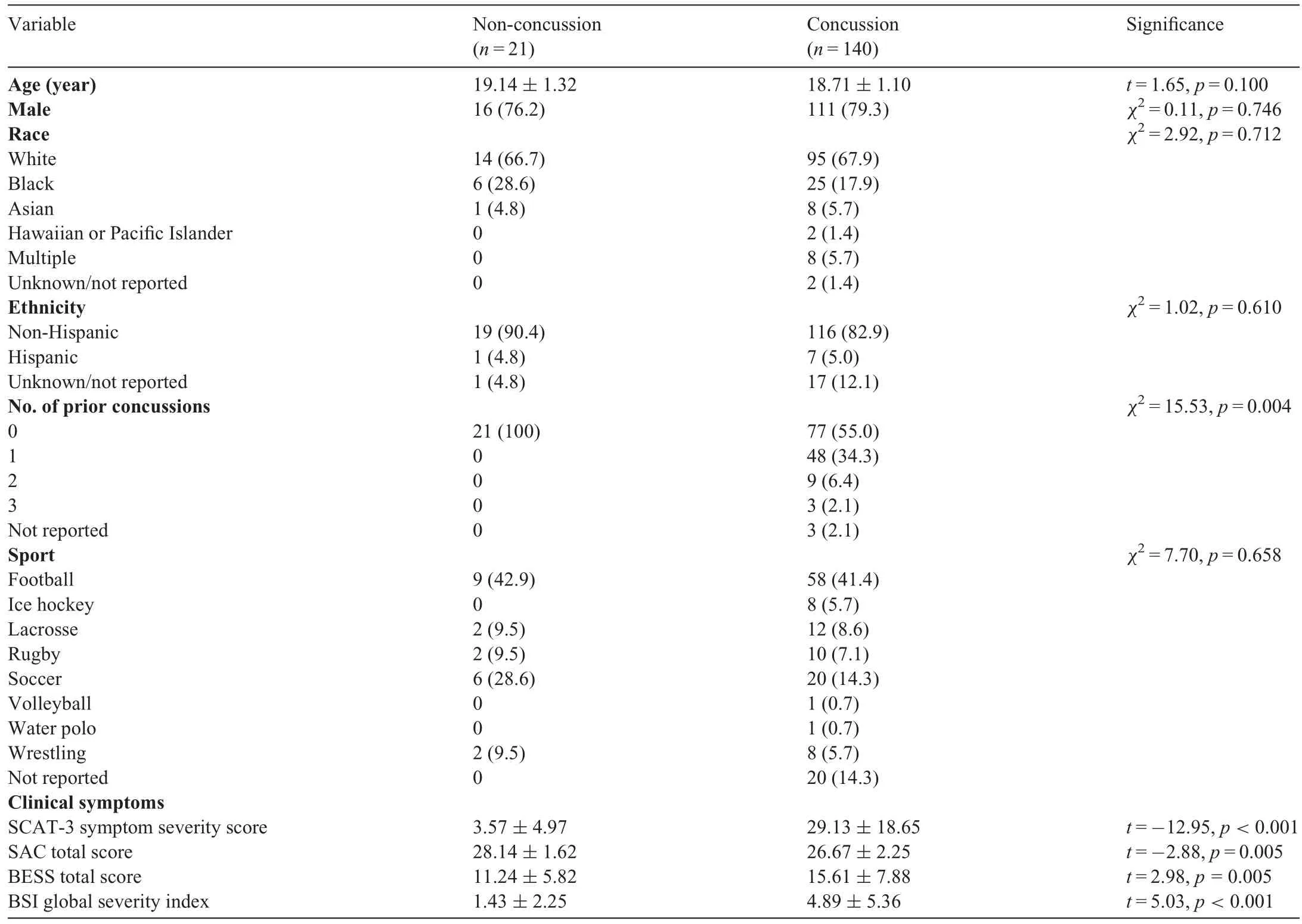
Table 1 Sample characteristics for concussed athletes and non-concussed athletes.
3.2. Protein changes in plasma of athletes with SRC
We found 338 proteins that differed in collegiate athletes who sustained SRC compared to non-concussed athlete controls.The proteins that were significantly more abundant after SRC were as follows:erythrocyte membrane protein band 4.1 (EPB41),apolipoprotein E (APOE),APOE isoform 2(APOE.2),APOE isoform 1(APOE.1),matrix metallopeptidase 3,and quinone oxidoreductase-like protein 1,etc.The proteins that were significantly less abundant after SRC were as follows:alpha-synuclein (SNCA),C-X-C motif chemokine ligand 1,CX-C motif chemokine ligand 6,SH2 domain containing 1A,and tyrosine kinase 2,etc.The top dysregulated proteins are listed in Table 2.All the differentially abundant proteins that were significant in concussed athletes relative to controls are listed in the online data Supplementary Table 1.The top 10 most differentially abundant proteins are presented in Fig.1.
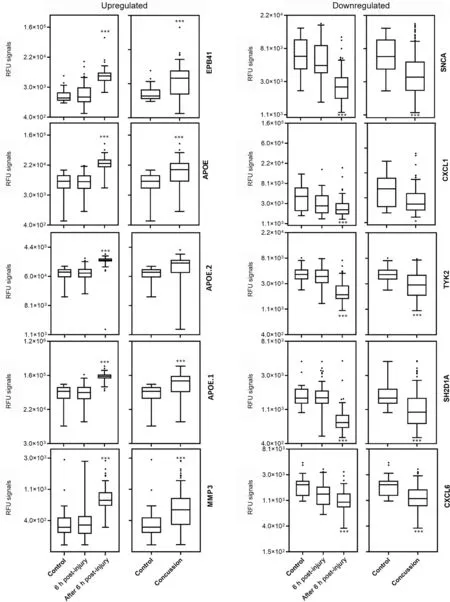
Fig.1.Top 10 proteins that are changed after injury.Protein levels are present in natural log transformed RFU values.The horizontal line in each box represents the median;the edges of the boxes represent the 25th and 75th percentiles.Significance differences are indicated with*p <0.05,**p <0.01,and***p <0.001.APOE=apolipoprotein E;APOE1=apolipoprotein E isoform 1;APOE2=apolipoprotein E isoform 2;CXCL1=C-X-C motif chemokine ligand 1;CXCL6=C-X-C motif chemokine ligand 6;EPB41=erythrocyte membrane protein band 4.1;MMP3=matrix metallopeptidase 3;RFU=relative fluorescence unit;SH2D1A=SH2 domain containing 1A;SNCA=alpha-synuclein;TYK2=tyrosine kinase 2.
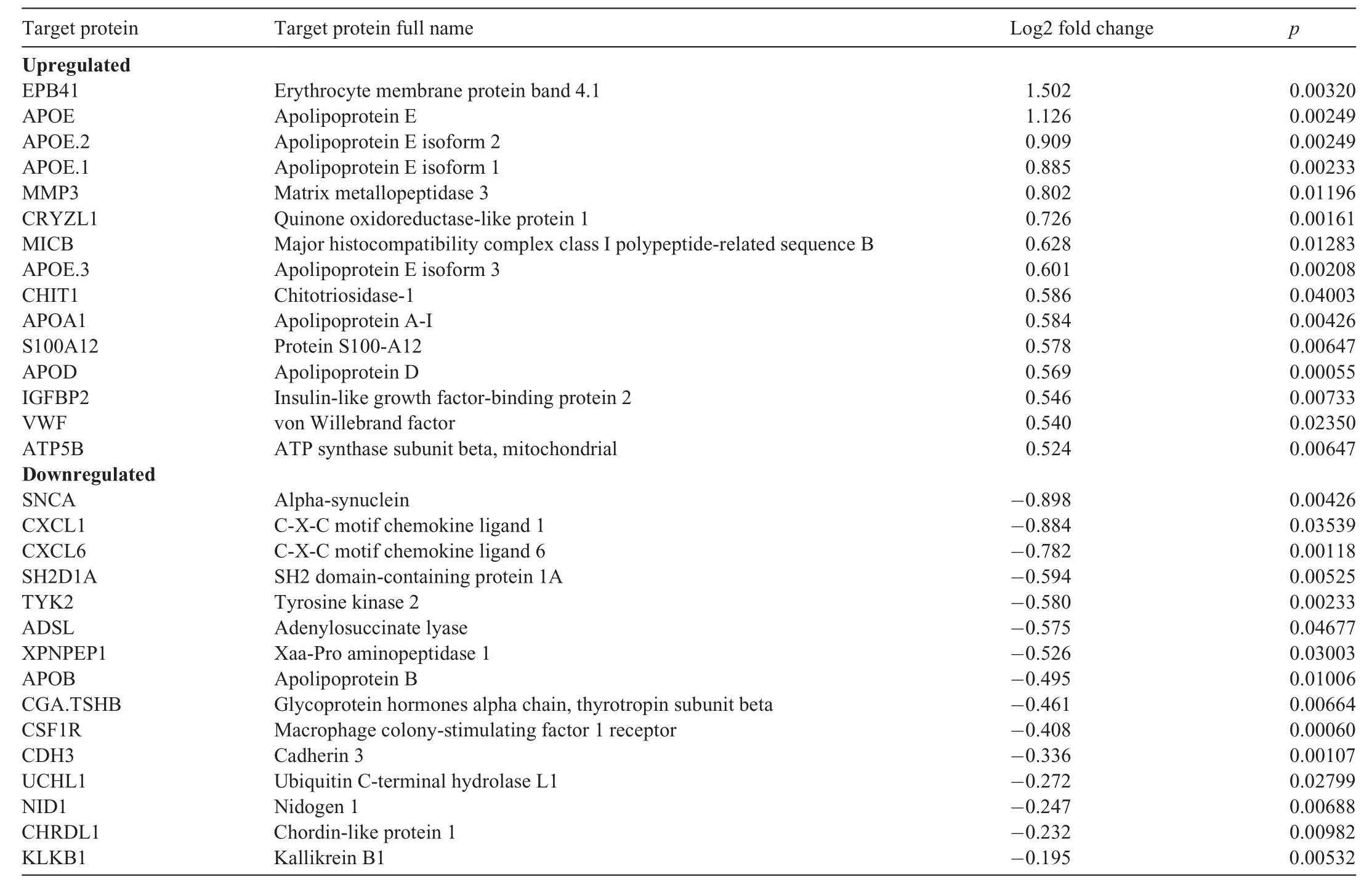
Table 2 Top protein changes in sport-related concussion.
3.3. Protein changes in plasma of SRC athletes within 6 h and after 6 h post-injury
Our findings identify several novel candidate biomarkers for diagnosis of concussion,including EPB41 and SNCA,which demonstrate high diagnostic accuracy.Further research is required to validate these proteins in a larger cohort of participants with sport-related concussion and other brain injuries.
3.4. Discrimination of concussed athletes from non-concussed athletes
We performed logistic regression and ROC analyses on the top 20 proteins to evaluate their ability to discriminate concussed athletes from non-concussed athletes.The AUC of the top 20 proteins for discriminating concussed athletes from non-concussed athletes 0-48 h after injury was 0.954 with a 95% confidence interval (95%CI) of 0.923-0.986 (Fig.2A).The ROC and AUC analyses were conducted on the clinical outcome measures of SCAT-3,BESS,and SAC.The AUC for SCAT-3 was 0.939 (95%CI: 0.894-0.984),for BESS it was0.681 (95%CI: 0.567-0.794),and for SAC it was 0.697(95%CI:0.582-0.812)(Supplementary Fig.1).
Catherine, she said, going up to the girl, which would you rather have-a happy youth or a happy old age? Catherine was so taken by surprise that she did not know what to answer, and the lady repeated again, Which would you rather have-a happy youth or a happy old age? Then Catherine thought to herself, If I say a happy youth, then I shall have to suffer all the rest of my life
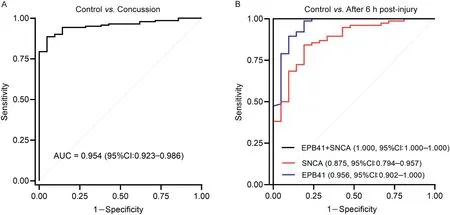
Fig.2.ROC curves for the top 20 proteins for distinguishing concussed athletes from non-concussed athletes.Predicted probabilities from logistic regression models were used to calculate the AUC for discriminating concussed athletes from non-concussed athletes.(A) AUC of top 20 proteins for discriminating concussed athletes from non-concussed athletes within 48 h of injury(AUC=0.954,95%CI:0.923-0.986).(B)After 6 h post-injury,a combination of the top 2 proteins—EPB41 and SNCA—showed an AUC of 1.000 for discriminating concussed athletes from non-concussed athletes.95%CI=95% confidence interval;AUC=area under the curve;EPB41=erythrocyte membrane protein band 4.1;ROC=receiver operating characteristic;SNCA=alpha-synuclein.TagedEnd
Proteomic analysis was performed in plasma samples using the SomaScan assay (SomaLogic).SomaScan (SomaLogic) is an aptamer-based assay that allows for the simultaneous measurement and quantification of 1305 proteins.Aptamers are single-stranded oligonucleotides that bind to protein targets with high affinity and specificity.5The affinity of analytes and specific aptamers effectively transforms a protein concentration into a nucleic concentration that can be read by standardized and very sensitive DNA detection methods.5,12Following the recommended sample preparation protocols,sample identifications were randomized in the SomaScan plate prior to loading to minimize the potential for artifacts due to specific loci in a microarray.Samples were stored in a freezer at -80°C before use,then thawed and loaded into pre-barcoded vials within the plate using pipette techniques in 55 μL aliquots;all samples and the plate were kept on wet ice(4°C)throughout the process.The plate was analyzed by SomaLogic,and standardization results were produced as relative fluorescent units.Standardized results consisted of the following procedural steps:hybridization control normalization,median signal normalization,and calibration normalization.First,sample data were normalized to remove hybridization variation within a run.Then,median signal normalization was performed across calibrator samples to remove other assay biases within the run.Overall scaling was then performed on a per-plate basis to remove overall intensity differences between runs.Finally,calibration was performed to remove assay differences between runs.
4.Discussion
SRC represents a sizable subset of mild traumatic brain injuries (mTBIs) and the broader spectrum of all-severity TBIs.Many candidate biomarkers have been investigated for diagnostic and clinical decision making after an mTBI,including total tau,neurofilament light,glial fibrillary acidic protein (GFAP),and ubiquitin C-terminal hydrolase-L1 (UCH-L1).4,14-17These biomarkers relate to neuronal,axonal,and astroglial damage following mTBIs.14,18GFAP and UCH-L1 are recognized as diagnostic markers,which in the future may be used to determine the necessity of obtaining computed tomography in the clinical setting following an mTBI.3,19To date,biomarker studies related to SRC have examined pre-determined candidate proteins thought to be related to the understood pathophysiology of concussions.However,this approach does not identify novel candidates,resulting in a limited accuracy for the diagnosis of SRC.The present study took a large-scale multiplexing proteomic approach to generating data by utilizing the SomaScan platform to examine 1305 proteins following an SRC.Here we expanded on our previous work,which used larger scale proteins to identify potential candidate biomarkers for concussion,and here we confirmed our previous results with respect to plasmaproteins,including GFAP,UCH-L1,microtubule associated protein tau,and inflammatory cytokines.4Among the novel biomarkers identified here,EPB41 and SNCA proteins have provided high diagnostic accuracy for concussion in athletes,even more than was demonstrated by previous findings.
A few months later, the wife came to the husband with a proposal, I read in a magazine, a while ago, about how we can strengthen our marriage, she offered. Each of us will write a list of the things that we find a bit annoying with the other person. Then, we can talk about how we can fix them together and make our lives happier together.
20 Charles, who adapted himself marvelously to the captain srole, was completely oblivious21 to her discomfort9; she noted10 with a returning sense of helplessness how much he enjoyed being in control
Statistical analyses were conducted using SPSS Version 28.0 (IBM,Armonk,NY,USA).The χ2test,Mann-Whitney-Wilcoxon tests,or Kruskal-Wallis tests were performed to determine group differences.The significance level was set atp<0.05 in all tests.The fold changes were calculated by using an interactive Shiny web tool framework developed by the NIH’s Center for Human Immunology,Autoimmunity,and Inflammation.13Adjustedpvalues were calculated by using the Benjamini-Hochberg’s false discovery rate with a cutoff value of 0.05.The top 20 proteins were selected and used to build the biomarker models for discriminating athletes with concussion from non-concussed athletes.Univariate logistic regression analyses with backward stepwise regression was performed to identify potential predictors for concussion.Predicted probabilities from logistic regression models were used to calculate the area under the curve (AUC) for significant biomarkers.Receiver operating characteristics(ROC)and AUC analyses were used to evaluate the ability of the protein concentrations to discriminate between diagnostic groups.Graphs were generated using GraphPad Prism Version 9.3(GraphPad Software,La Jolla,CA,USA).
One afternoon, a little boy had lost his puppy1. He looked under his bed. He looked all over his house. But still there was no puppy. Finally, he looked for his puppy in the garden. After a few hours, he still could not find the puppy.
Acknowledgments
To our knowledge,our study represents the first exploratory,large-scale proteomic study of SRC.Nevertheless,this study has several limitations.The time to blood draw varied across participants,resulting in a 0-48 h interval,and the sample consisted primarily of White and non-Hispanic males,which limited our ability to generalize to all athletes with SRC.It is also unclear whether the current results will apply to other populations (e.g.,non-athletes,younger athletes).Moreover,our study had a relatively small number of athletes(both concussed and non-concussed) due to the expense of conducting SomaScan analysis.Something else to consider is that the majority of our concussed athletes were participating in contact sports.It is possible that sub-concussive hits may have contributed to these findings.Additional studies are required to investigate these novel protein biomarkers in other sports and other concussed populations.Another limitation is that our control group of non-concussed athletes may have included individuals who did not report symptoms/injuries to health-care providers or whose SRC may have gone unidentified.Since the mechanism of injury can vary widely across the injury cohort,some SRC may impact brain neurophysiology.As a result,we suggest larger,more inclusive studies of these biomarkers.Finally,the subgroup analysis of candidate biomarkers within 6 h post-injury were not significant after being adjusted for multiple comparisons.Therefore,we did not assess their ability to differentiate athletes with concussion from controls.However,these proteins may provide important insight into the physiological response to injury at the acute time point.For example,our data showed a greater abundance of cardiac-related proteins within 6 h post-injury;these included troponin T,troponin I,and fatty acid binding protein 3 (FABP3).These proteins are found predominantly in the cardiac and skeletal muscles and play an important role in regulating myocardium contraction.The presence of these proteins in peripheral blood circulation following myocardium cell damage serves as a biomarker of acute myocardial infarction.31,32Additionally,elevated levels of these enzymes have been reported in stroke and severe TBI patients without myocardium injury.33-35Thus,elevated levels of cardiac muscle-specific enzymes in our study may relate to physiological stress following SRC.36FABP3 is also expressed in the dopaminergic neuron and plays an important role in regulating intracellular fatty acid transportation,metabolism,and energy homeostasis.37,38Overexpression of FABP3 has been shown to induce dopaminergic neuron toxicity and lead to neurodegeneration by stimulating SNCA oligomerization and accumulation.39Therefore,the proteins from this subgroup analysis may provide a better understanding of biological response and inform future research in the clinical study of concussion.
5.Conclusion
To understand the impact of time since injury (0-48 h)on the observed protein abnormalities,athletes with concussion were divided into 2 groups: 6 h post-injury(0-6 h post-injury,n=65) and after 6 h post-injury (7-48 h post-injury,n=75).Our results showed that within the first 6 h post-injury,66 proteins were differentially abundant in the plasma of collegiate athletes with SRC compared to non-concussed athletes.However,these proteins were not significant after correction for multiple comparisons,and the results should be interpreted cautiously.Among them,49 proteins were more abundant and 17 proteins were less abundant after injury.All differentially abundant proteins are listed in the online data Supplementary Table 2.After 6 h post-injury,694 proteins were differentially abundant,of which 624 proteins were significantly more abundant and 70 proteins less so.All differentially abundant proteins are listed in the online data Supplementary Table 3.
Then she left the tower and drove the geese into a field. And when they had reached the common where the geese fed she sat down and unloosed her hair,33 which was of pure gold.34 Curdken loved to see it glitter in the sun, and wanted much to pull some hair out.35 Then she spoke23:
The authors thank the research and medical staff at each of the CARE participation sites.This research was supported by the Grand Alliance CARE Consortium,funded in part by the National Collegiate Athletic Association (NCAA) and the Department of Defense (DoD).This work was supported by the Office of the Assistant Secretary of Defense for Health Affairs,through the Combat Casualty Care Research Program,endorsed by the Department of Defense,under Award No.W81XWH1420151.Opinions,interpretations,conclusions,and recommendations are those of the author and are not necessarily endorsed by the DoD.
Authors’contributions
RV participated in the proteomics analysis,interpretation of data,and drafting of the manuscript;JMG,MAM,CCG,KLC,PP,SPB,JH,KMG,and TBM contributed to the study design and coordination and critical revision of the manuscript.All authors participated in the interpretation of data and critical revisions of the manuscript for important intellectual content.All authors have read and approved the final version of the manuscript,and agree with the order of presentation of the authors.
Competing interests
TBM receives compensation as a member of the Clinical and Scientific Advisory Board for Quadrant Biosciences Inc.SPB has current or past research funding from the National Institutes of Health;Centers for Disease Control and Prevention;Department of Defense -USA Medical Research Acquisition Activity,National Collegiate Athletic Association;National Athletic Trainers’ Association Foundation;National Football League/Under Armour/GE;Simbex;and ElmindA.He has consulted for US Soccer(paid),US Cycling (unpaid),University of Calgary SHRed Concussions external advisory board (unpaid),medico-legal litigation,and received speaker honorarium and travel reimbursements for talks given.He is co-author of“Biomechanics of Injury (3rd edition)” and has a patent pending on “Brain Metabolism Monitoring Through Cytochrome-C-Oxidase (CCO) Measurements Using All-Fiber-Integrated Super-Continuum Source” (U.S.Application No.17/164,490).JPM reports grants from National Collegiate Athletic Association and from Department of Defense during the conduct of the study;grants from National Institutes of Health,National Football League,Centers for Disease Control and Prevention outside the submitted work.MAM reports grants from Department of Defense and from National Collegiate Athletic Association during the conduct of the study.No other disclosures were reported.All the support had no involvement in the study design and writing of the manuscript or the decision to submit it for publication.
Supplementary materials
Supplementary materials associated with this article can be found in the online version at doi:10.1016/j.jshs.2022.11.007.
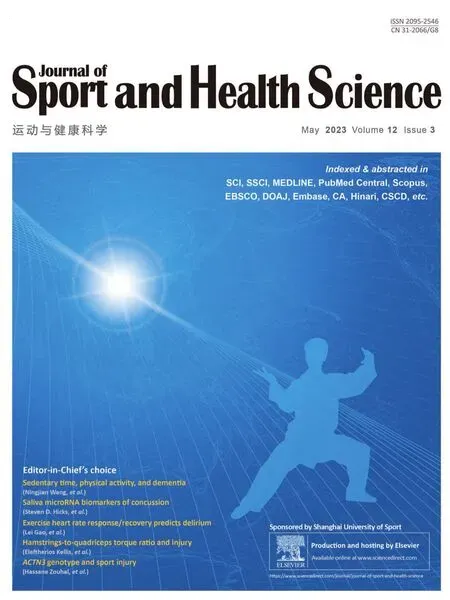 Journal of Sport and Health Science2023年3期
Journal of Sport and Health Science2023年3期
- Journal of Sport and Health Science的其它文章
- Impact loading in female runners with single and multiple bone stress injuries during fresh and exerted conditions
- Refinement of saliva microRNA biomarkers for sports-related concussion
- Factors and expectations influencing concussion disclosure within NCAA Division I athletes:A mixed methodological approach
- Effects of contact/collision sport history on gait in early-to mid-adulthood
- Association between ACTN3 R577X genotype and risk of non-contact injury in trained athletes:A systematic review
- Lacrosse-related injuries in boys and girls treated in U.S.emergency departments,2000-2016
